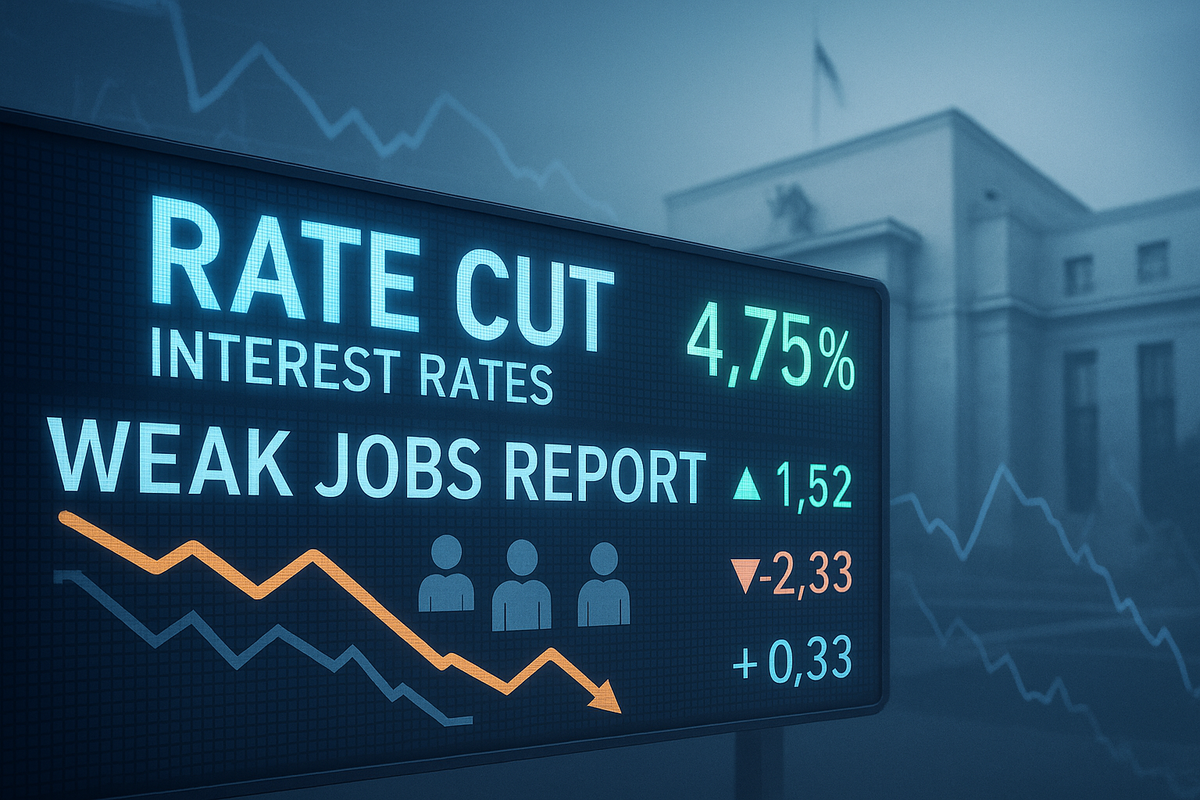
The financial markets are abuzz with renewed speculation regarding a potential interest rate cut by the Federal Reserve, following the release of a surprisingly weak July jobs report. This critical economic data, which revealed sluggish labor market growth and downward revisions to previous months' figures, has significantly altered the landscape for monetary policy expectations. Investors are now increasingly pricing in the likelihood of the Fed easing its stance, a stark contrast to earlier sentiments that had largely dismissed significant rate cuts for the remainder of the year.
This shift in outlook is not merely a reaction to a single data point; it reflects a broader concern about the health of the U.S. economy. Coupled with an uptick in inflation and signs of weakening consumer spending, the July jobs report has intensified the debate among economists and policymakers about the appropriate path forward for interest rates. The immediate market reaction, characterized by rising stock indices and falling Treasury yields, underscores the profound implications of this data for asset valuations and investor strategies.
Weak July Jobs Report Signals Potential Economic Slowdown
The July 2025 jobs report delivered a significant jolt to market expectations, painting a picture of a cooling labor market that could prompt a pivotal shift in the Federal Reserve's monetary policy. Non-farm payrolls increased by a modest 105,000 jobs, falling considerably short of the anticipated 180,000 and marking a notable deceleration from prior months. This figure suggests a more rapid cooling of the economy than many had foreseen.
Further compounding concerns, the unemployment rate edged up to 4.1%, surpassing forecasts and indicating a loosening in the labor market. Wage growth also showed signs of moderation, with average hourly earnings rising by a mere 0.2% month-over-month, below the 0.3% forecast. These collective figures present a compelling case for a weakening employment landscape, a key metric the Federal Reserve meticulously monitors when deliberating on interest rate adjustments. The report also included downward revisions to previous months' data, further solidifying the narrative of a decelerating job market.
The timeline leading up to this moment has been characterized by a delicate balancing act for the Fed, navigating persistent inflation while attempting to avoid a recession. For months, the central bank has maintained a hawkish stance, emphasizing its commitment to bringing inflation down to its 2% target. However, the July jobs report, combined with recent inflation data showing an uptick and anecdotal evidence of weakening consumer spending, has provided new impetus for a re-evaluation of this strategy. Key players and stakeholders, including Federal Reserve officials, economists, and market analysts, are now intensely scrutinizing every piece of economic data for clues on the Fed's next move.
Initial market reactions were swift and decisive. Major U.S. stock indices, including the S&P 500 (SPX) and Nasdaq Composite (IXIC), saw immediate gains as investors anticipated that lower interest rates would bolster corporate earnings and stimulate economic activity. Technology and growth stocks, often more sensitive to interest rate fluctuations, were particularly favored. Concurrently, U.S. Treasury yields, which move inversely to bond prices, fell sharply, with the benchmark 10-year Treasury note yield dropping significantly. This decline reflected increased demand for bonds as a safe haven and in anticipation of lower future interest rates, signaling that investors are now pricing in a higher probability of rate cuts. The U.S. dollar also weakened against a basket of major currencies, as the prospect of rate cuts typically makes a country's currency less attractive to foreign investors seeking higher yields.
Winners and Losers in a Shifting Economic Landscape
A potential Federal Reserve interest rate cut, spurred by a weakening economy, would create a distinct set of winners and losers across various sectors of the financial market. While lower rates are generally intended to stimulate economic activity, the simultaneous signs of economic deceleration introduce complexities that will impact industries and individual companies in diverse ways.
The real estate and housing sector stands to be a significant beneficiary. Lower interest rates directly translate to more affordable mortgages, boosting homebuyers' purchasing power and stimulating demand. This could lead to increased home sales, more competitive markets, and potentially rising home prices. Homebuilders such as D.R. Horton (NYSE: DHI) and Lennar (NYSE: LEN) would likely see increased demand for new homes, leading to higher sales and construction activity. Similarly, Real Estate Investment Trusts (REITs), particularly residential REITs, could benefit from reduced borrowing costs, improving their profitability and making property acquisitions more attractive. Mortgage lenders like Rocket Companies (NYSE: RKT) and UWM Holdings (NYSE: UWMC) would also likely experience a surge in refinancing and new mortgage applications, increasing their loan origination volumes.
Highly leveraged companies are another group poised to benefit. Businesses with substantial debt burdens, especially those with variable-rate debt, would see a reduction in their interest expenses. This lowers their cost of capital, improves profit margins, and frees up cash flow. While specific public examples are harder to pinpoint without detailed knowledge of their debt structures, companies in capital-intensive industries or those that have recently undergone leveraged buyouts (LBOs) could see improved financial health. Private equity firms, which frequently use significant leverage in their deals, would also find debt financing cheaper, potentially amplifying returns on equity investments and spurring merger and acquisition activity.
Growth stocks, particularly in the technology and small-cap sectors, could also see a tailwind. Lower interest rates increase the present value of future profits, which is particularly advantageous for growth companies valued on their long-term earnings potential. Cheaper capital also reduces borrowing costs for younger, fast-growing companies that often rely on external funding. While a weakening economy might lead to reduced IT budgets and cautious corporate investments, lower interest rates can still provide a boost for technology giants like NVIDIA (NASDAQ: NVDA), Microsoft (NASDAQ: MSFT), and Amazon (NASDAQ: AMZN) by making capital cheaper for innovation and expansion, especially for those with strong cash flows and benefiting from trends like AI. Small-cap companies, often more sensitive to borrowing costs due to less diverse funding sources, could see significant improvements in their financial flexibility.
Conversely, the financial sector, particularly large commercial banks, could face headwinds. While lower rates might increase loan demand, they can also compress banks' net interest margins (NIMs) – the difference between what banks earn on loans and what they pay on deposits. A weakening economy could also lead to an increase in loan delinquencies and defaults, further impacting bank profitability. Major players like JPMorgan Chase (NYSE: JPM) and Bank of America (NYSE: BAC) might see their net interest income decline as the spread between lending and borrowing rates narrows.
The consumer discretionary sector is also vulnerable. This sector includes companies selling non-essential goods and services, such as automobiles, luxury items, restaurants, and entertainment. A weakening economy directly impacts consumer confidence and disposable income, leading to reduced spending on these items. Auto manufacturers like Tesla (NASDAQ: TSLA) and General Motors (NYSE: GM) are highly sensitive to economic conditions and consumer confidence, as are financing costs. While some fast-food chains might be resilient, overall restaurant and leisure spending tends to decline. Retailers like Home Depot (NYSE: HD) and Lowe's (NYSE: LOW), while potentially benefiting from lower mortgage rates, could still see consumers delay home improvement projects in a weakening economy. Luxury brands, such as those under LVMH (OTCMKTS: LVMUY), are typically among the first to be cut from budgets during an economic slowdown.
Finally, companies highly dependent on strong corporate spending, particularly in certain segments of the technology sector, could also suffer. While some tech companies benefit from cheaper capital, a weakening economy often prompts businesses to cut back on IT budgets and discretionary spending, impacting enterprise software, hardware, and consulting services. Companies like IBM (NYSE: IBM) and Oracle (NYSE: ORCL), heavily reliant on large corporate IT contracts, might experience project delays or cancellations. Similarly, manufacturers of heavy equipment like Caterpillar (NYSE: CAT), whose sales are closely tied to industrial activity and large-scale construction projects, could see significant slowdowns.
Industry Impact and Broader Implications of a Monetary Policy Shift
A potential Federal Reserve interest rate cut, driven by the recent weak jobs report and broader signs of economic weakening, would send significant ripple effects across various industries and have profound broader implications for the U.S. and global economies. This move would fit into a broader trend of central banks globally adjusting monetary policy in response to evolving economic conditions, particularly in the face of persistent inflation and concerns about growth deceleration.
The primary aim of a Fed rate cut in this scenario is to stimulate economic activity by lowering borrowing costs for businesses and consumers, thereby encouraging spending and investment. Capital-intensive industries such as construction, manufacturing, and real estate are particularly sensitive to interest rate changes. Lower rates make large projects more affordable, potentially leading to increased investment, expansion, and job growth in these sectors. For instance, the housing market is expected to see improved activity as mortgage rates trend lower, though lingering affordability issues could still temper a dramatic surge in sales. This could provide a much-needed boost to homebuilders and related industries.
The ripple effects would extend to consumer spending and discretionary goods. Lower interest rates on credit cards, auto loans, and personal loans can reduce debt burdens and make new purchases more attractive, potentially boosting demand for manufactured goods and services. This could provide a lifeline to consumer discretionary sectors that have been facing headwinds from inflation and cautious consumer behavior. However, the financial sector, while benefiting from increased loan demand, could simultaneously face pressure on its profitability due to narrowed net interest margins (NIMs).
In terms of competitors and partners, lower borrowing costs could enable businesses to invest more in expansion, research and development, and market share acquisition, potentially intensifying competition within industries. Supply chain partners, particularly in manufacturing and logistics, could see increased demand as businesses expand and consumer spending rises. Conversely, if the economic weakening persists despite rate cuts, some partners might face reduced orders and tighter margins. Furthermore, lower interest rates generally make financing mergers and acquisitions (M&A) more attractive, potentially leading to a resurgence in deal activity and industry consolidation as companies seek efficiencies or market share in a more affordable borrowing environment.
From a regulatory and policy perspective, the weak jobs report places significant pressure on the Federal Reserve's dual mandate of achieving maximum employment and stable inflation. If inflation remains elevated despite a weakening labor market, the Fed faces a tricky balancing act. This economic environment might also prompt discussions about complementary fiscal policies, such as government spending or tax adjustments, to further stimulate growth. The ongoing impact of tariffs, which can create headwinds for growth and potentially reignite inflation, further complicates the Fed's decision-making process.
Historically, there are several precedents for Fed rate cuts in response to economic weakening. During the 2008-2009 Great Recession, the Fed drastically cut rates to near zero to stabilize the economy. While these cuts eventually helped restore business confidence and led to increased hiring and recovery, job creation was not immediate, and unemployment initially surged. Similarly, during the COVID-19 pandemic in 2020, rate cuts were implemented to stabilize the economy, leading to an uneven but eventual recovery of many pandemic-related job losses. It's worth noting that the S&P 500 Index has historically posted positive returns in 86% of the 12-month periods following an initial rate cut, averaging 14.1% since 1980. However, rate cut cycles are often associated with elevated market volatility, both before and after the initial cut. This historical context suggests that while rate cuts are a critical tool for economic stabilization, their impact on employment and broader recovery may not always be immediate or uniform across all sectors.
What Comes Next: Navigating the Shifting Sands of Monetary Policy
The immediate aftermath of the weak July jobs report and the subsequent reignition of Federal Reserve rate cut hopes ushers in a period of intense scrutiny and strategic recalibration for businesses, investors, and consumers alike. The short-term possibilities point towards increased market volatility and a potential re-evaluation of portfolio allocations, while the long-term trajectory hinges on the Fed's ability to navigate a delicate balance between stimulating growth and containing inflation.
In the short term, the market is now largely pricing in a September rate cut, with some estimates reaching as high as 80-90% probability. This has already led to a significant drop in U.S. Treasury yields, particularly for shorter-dated maturities, reflecting expectations of imminent easing. For the stock market, while rate cuts are generally perceived as positive, the immediate aftermath can be volatile. Historically, the S&P 500 has experienced losses following the initial rate cut, as such cuts often signal an economy already grappling with challenges. However, certain sectors may emerge as relative outperformers. Defensive sectors like consumer non-cyclicals (staples), healthcare, and utilities have historically shown stronger returns in the six months following an initial rate cut, especially if a recession is averted. The U.S. dollar is also likely to weaken against major currencies, potentially providing a tailwind for U.S. corporate profits from international sales.
Looking further ahead, the long-term implications are more complex. If the rate cuts successfully stabilize the economy without triggering a full-blown recession, a "soft landing" scenario could unfold, where economic growth moderates but avoids a sharp downturn. However, if the cuts are a response to a rapidly deteriorating economy, they might not be enough to prevent a recession. The Fed's ultimate goal is to bring rates down to a neutral level, not necessarily a highly stimulative one, to avoid reigniting inflationary pressures. The presence of tariffs, which can exert upward pressure on prices, adds another layer of complexity, raising the risk of stagflation – a challenging scenario of weak growth coupled with persistent inflation.
Strategic pivots will be crucial for all stakeholders. Businesses may initially delay major hiring and layoff decisions until economic uncertainty subsides, but lower borrowing costs could eventually spur investment, particularly in cyclical industries. Construction firms, for example, might continue their pivot towards public and institutional work if private capital remains cautious, prioritizing backlog quality over quantity. For investors, recalibrating portfolios is paramount. This may involve selectively tilting towards growth stocks, rotating into lagging cyclicals (like small-caps, financials, and industrials if growth stabilizes), and considering defensive sectors for resilience. Extending bond exposure cautiously, prioritizing high-grade corporate and government bonds, is also a strategic move. Given the likelihood of continued market swings, allocating a portion of the portfolio to low-volatility equities or cash equivalents can help buffer against volatility. For consumers, a weaker jobs market could impact sentiment and spending, though lower interest rates might encourage borrowing for large purchases like homes.
Several potential scenarios and outcomes could emerge. The most optimistic is a soft landing, where the Fed's actions successfully stabilize the economy, and inflation continues to moderate, leading to equity outperformance over the subsequent 12 months. Conversely, if the weak jobs report is a harbinger of a more significant economic slowdown, rate cuts might be insufficient or too late to prevent a recession, in which case stocks could experience steep losses. The risk of stagflation remains, particularly if ongoing tariff policies continue to raise consumer prices, leading to weak growth and persistent inflation. Finally, an inflationary resurgence could occur if the Fed cuts rates too quickly or if underlying inflationary pressures (e.g., from tariffs) prove more stubborn, potentially forcing the Fed to reverse course later. The current economic environment, characterized by easing but still above-target inflation, a cooling but resilient labor market, and the added complexity of global trade tensions, makes the Fed's decisions a critical litmus test for its credibility.
Conclusion: A Pivotal Moment for the Market
The weak July jobs report has undeniably marked a pivotal moment for the financial markets, reigniting fervent speculation about a Federal Reserve interest rate cut and fundamentally altering the near-term outlook for monetary policy. The key takeaway is that the U.S. labor market is showing clear signs of deceleration, a development that, when coupled with persistent inflation and weakening consumer spending, significantly increases the probability of the Fed easing its hawkish stance. This shift has already triggered immediate market reactions, with stock indices rising and Treasury yields falling, as investors begin to price in a lower interest rate environment.
Moving forward, the market will be closely watching for further economic data that either confirms or contradicts the narrative of a weakening economy. Investors should anticipate continued volatility as the market digests new information and attempts to predict the Fed's next moves. The potential for a rate cut presents both opportunities and challenges. While lower borrowing costs could stimulate growth in interest-sensitive sectors like real estate and benefit highly leveraged companies, it could also squeeze profit margins for banks and dampen consumer discretionary spending if economic weakness persists.
In the coming months, investors should pay close attention to several key indicators: subsequent jobs reports for signs of further labor market cooling, inflation data to gauge the effectiveness of current monetary policy and the impact of tariffs, and consumer spending figures for insights into overall economic health. The Federal Reserve's communications will be paramount, as any hints about their future policy direction will heavily influence market sentiment. The ultimate significance and lasting impact of this event will depend on whether the Fed's potential rate cuts successfully engineer a soft landing, or if they merely confirm a more significant economic downturn. The delicate balancing act between controlling inflation and supporting employment will define the economic landscape for the foreseeable future.





